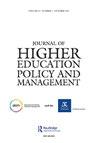包容的就业能力:迫切需要一个生物心理社会模型的观点
IF 2.4
3区 教育学
Q1 EDUCATION & EDUCATIONAL RESEARCH
Journal of Higher Education Policy and Management
Pub Date : 2023-09-14
DOI:10.1080/1360080x.2023.2258324
引用次数: 1
摘要
摘要残疾的定义正在发生变化,从狭隘的医学诊断转向残疾的生物心理社会模型,其中残疾被概念化为一系列可能在环境中对个人不利的关系条件。这种对残疾的新理解将对高等教育部门产生重大影响,在高等教育部门,残疾学生的参与越来越多。在本文中,我们通过毕业生就业能力的主题来讨论这些影响的一个方面。在此过程中,我们提出了一个新的概念“就业能力促进包容性”,可以作为大学考虑就业能力倡议如何包容残疾和/或多元化学生的公平焦点。为了解释这一概念,我们进一步说明了残疾的生物心理社会模型如何影响关键的就业活动(例如,工作结合学习),并为高等教育部门如何采用新兴的残疾和包容概念提供了有价值的见解。关键词:毕业生就业公平与包容残疾工作整合学习内在课程要求职业发展学习披露声明作者未报告潜在的利益冲突。本文章由计算机程序翻译,如有差异,请以英文原文为准。
Employability for inclusion: the urgent need for a biopsychosocial model perspective
ABSTRACTDefinitions of disability are changing, shifting from a narrow medical diagnosis to a biopsychosocial model of disability, where disability is conceptualised as a series of relational conditions that can potentially disadvantage individuals within environments. Implications of this new understanding of disability will have significant effects in the higher education sector, where there is increasing participation of disabled students. In this paper, we discuss one aspect of these implications through the topic of graduate employability. In doing so, we generate a new concept ‘Employability for Inclusion’ that can be utilised as an equity-focused lens for universities to consider how employability initiatives are inclusive to disabled and/or diverse students. To unpack this concept, we further illustrate how a biopsychosocial model of disability would impact key employability activities (e.g., work-integrated learning) and provide valuable insights into how the higher education sector can adopt emerging conceptualisations of disability and inclusion.KEYWORDS: Graduate employabilityequity and inclusiondisabilitywork-integrated learninginherent course requirementscareer development learning Disclosure statementNo potential conflict of interest was reported by the author(s).
求助全文
通过发布文献求助,成功后即可免费获取论文全文。
去求助
来源期刊

Journal of Higher Education Policy and Management
EDUCATION & EDUCATIONAL RESEARCH-
CiteScore
5.30
自引率
7.70%
发文量
52
期刊介绍:
The Journal of Higher Education Policy and Management is an international journal of professional experience and ideas in post-secondary education. It is a must read for those seeking to influence educational policy making. The journal also aims to be of use to managers and senior academic staff who seek to place their work and interests in a broad context and influence educational policy and practice.
 求助内容:
求助内容: 应助结果提醒方式:
应助结果提醒方式:


